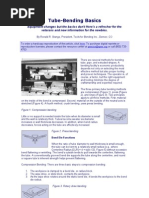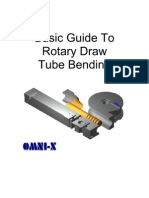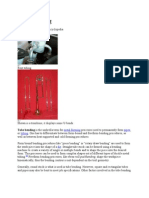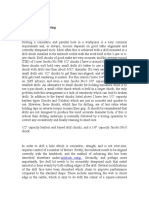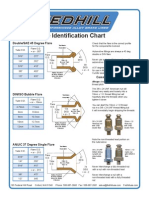3.4 Cold Bending: Yct Technical Guide 3-Section 3 - Installation Guide
3.4 Cold Bending: Yct Technical Guide 3-Section 3 - Installation Guide
Uploaded by
mohansafCopyright:
Available Formats
3.4 Cold Bending: Yct Technical Guide 3-Section 3 - Installation Guide
3.4 Cold Bending: Yct Technical Guide 3-Section 3 - Installation Guide
Uploaded by
mohansafOriginal Description:
Original Title
Copyright
Available Formats
Share this document
Did you find this document useful?
Is this content inappropriate?
Copyright:
Available Formats
3.4 Cold Bending: Yct Technical Guide 3-Section 3 - Installation Guide
3.4 Cold Bending: Yct Technical Guide 3-Section 3 - Installation Guide
Uploaded by
mohansafCopyright:
Available Formats
3.
4 Cold Bending
(5)
Half-hard copper tubing to BS EN 1057 R250 in straight lengths is in an ideal condition for cold
bending, using either a bending spring or a machine as appropriate. Nevertheless, to achieve
consistently satisfactory bends some basic precautions must be observed:
3.4.1 Spring Bending
During internal spring bending, the use of a little lubricating oil or grease greatly assists the bending
operation and prolongs the life of the spring by preventing rusting.
As with any equipment, bending springs must be kept in good condition and when worn they should
be replaced. Internal bending springs are normally used for half-hard, 12, 15 and 22mm tubing,
although clearly the choice of spring depends on the wall thickness of the tube being manipulated.
For example, the nominal internal diameter of 15mm Yorkex tubing is 13.6mm, whereas that of
15mm Kuterlon material is only 13mm. It is essential to use the appropriate size of spring that fits
snugly into the tube. Bends can usually be made by hand, bending gradually but firmly around the
knee, to a minimum radius of around 5 times the diameter of the tubing in question.
Although some plumbers occasionally use an internal spring for larger tube sizes, it should be noted
(4)
that this practice is not recommended or indeed allowed for in BS 5431 (the British Standard for
bending springs). Hence consistently satisfactory spring bending of tubes in sizes above 22mm
cannot be guaranteed.
External bending springs are also available for half-hard tube in sizes up to and including 10mm.
3.4.2 Machine Bending
Bending machines form significantly tighter bends (minimum root/inside radius approximately 3 x o.d.
of tube) than are possible using a spring. This method is by far the most widely used for bending
copper tubes in the U.K. Machines are supplied by various manufacturers in many forms but
essentially fall into one of two categories, i.e. "non-adjustable" or "adjustable".
3.4.2.1 Non-adjustable Machine Bending
Non-adjustable bending machines are commonly used for bending smaller size tubes (i.e. up to and
including 22mm o.d.). These benders offer two main advantages over adjustable machines in that
they are relatively inexpensive and usually light in weight, hence more portable.
When choosing a non-adjustable bender care should be taken to ensure that the machine is suitable
for bending the specification of the tube being used.
As with any tooling, care should always be taken with maintenance, with particular regard to the
replacement of worn guides or formers (preferably with a matched pair).
3.4.2.2 Adjustable Machine Bending
Adjustable bending machines are readily available in sizes up to and including 28mm. Occasionally,
they may be employed to manipulate half-hard tubing in sizes up to and including 54mm. They have
the advantage of allowing the operator to adjust the pressure applied to the tube, via the guide,
thereby compensating for any slight tooling wear or even marginal differences in physical and
mechanical properties between different batches of tube, albeit within the confines of the
specification.
The point at which bending pressure is exerted on the tube is crucial and must be maintained at a
fixed distance in front of the point of support of the former. If this distance is too small, excessive
necking (or throating) at either end of the bend will occur; too great and corrugations or wrinkles
may result along the inside radius.
Clearly, manipulation of medical quality tubing must be undertaken using equipment applied to the
outside of the tube only, since internal springs will compromise the cleanliness of the bore.
N.B.
It should be noted that bending has no detrimental effect on maximum safe working
pressures of half-hard tubes, since any slight reduction in wall thickness along the outer radii
of bends is off-set by the increase in hardness of the tube in the manipulated region.
YCT TECHNICAL GUIDE
3-6
Section 3 INSTALLATION GUIDE
Issue 02/14
You might also like
- Owner'S Manual: 2.4L 25kW ModelsDocument68 pagesOwner'S Manual: 2.4L 25kW ModelsCarlos Angarita0% (1)
- Ninjacart: The ProblemDocument10 pagesNinjacart: The ProblemAkash Dherange100% (1)
- Reading Comprehension - MonkeyDocument2 pagesReading Comprehension - MonkeyNuria RuedaNo ratings yet
- Tube Bending BasicsDocument6 pagesTube Bending Basicsjosetxu2006No ratings yet
- FlowconME Valves Catalogue 14Document1 pageFlowconME Valves Catalogue 14mohansafNo ratings yet
- E-Ticket Receipt: MR Mohamed Ansaf Kachchu MohamedDocument1 pageE-Ticket Receipt: MR Mohamed Ansaf Kachchu Mohamedmohansaf100% (1)
- BOP ComponentsDocument8 pagesBOP ComponentsrahulNo ratings yet
- Tube and Section Bends: The Processes and Their ApplicationsDocument8 pagesTube and Section Bends: The Processes and Their ApplicationssolquihaNo ratings yet
- 25 Omni X Tube Bending GuideDocument15 pages25 Omni X Tube Bending GuideMartin SilisqueNo ratings yet
- Annular BOPSDocument44 pagesAnnular BOPSF BesarNo ratings yet
- TECOtubeexpanders BROCHUREDocument56 pagesTECOtubeexpanders BROCHUREMontajes Industriales EOS, MIESANo ratings yet
- Omni-X Tube Bending GuideDocument15 pagesOmni-X Tube Bending GuidemsppmsNo ratings yet
- DS Design PDFDocument73 pagesDS Design PDFOgxar3 NadirNo ratings yet
- Separation PDFDocument10 pagesSeparation PDFJose Leonardo Materano PerozoNo ratings yet
- University of ZakhoDocument4 pagesUniversity of ZakhoNasih AhmadNo ratings yet
- Tube BendingDocument8 pagesTube BendingRohan Paunikar100% (1)
- Adhesion Test For Layflat Hoses PDFDocument10 pagesAdhesion Test For Layflat Hoses PDFAaron Homing NiNo ratings yet
- Boosting Deep-Hole Drilling Productivity Up To 10 Times (MAN August 1999) PDFDocument3 pagesBoosting Deep-Hole Drilling Productivity Up To 10 Times (MAN August 1999) PDFchidambaram kasiNo ratings yet
- Oil Drilling Assignment: Topic: DrillstringDocument8 pagesOil Drilling Assignment: Topic: DrillstringMuhammad Fawwad ObaidaNo ratings yet
- Mfe24pi1505 Design of Production Toolingdrill BushingsDocument14 pagesMfe24pi1505 Design of Production Toolingdrill BushingsSubrat pandaNo ratings yet
- Amtg Hdbk Chap9_tubing RelDocument25 pagesAmtg Hdbk Chap9_tubing RelBrandon ColeNo ratings yet
- Bending The RulesDocument2 pagesBending The RuleskikiuNo ratings yet
- Jeppesen Fluid Lines and FittingsDocument53 pagesJeppesen Fluid Lines and FittingsMarlou DyNo ratings yet
- RAMS SelectionDocument14 pagesRAMS SelectionWilliamNo ratings yet
- PFI ES 24 Pipe BendingDocument24 pagesPFI ES 24 Pipe BendingSrinivas Jasti100% (1)
- Conduiting WorkDocument24 pagesConduiting Worknaam9No ratings yet
- ProjectDocument36 pagesProjectSahilye Geha100% (1)
- Completion Technology For Slim Hole Wells - Wipertrip PDFDocument10 pagesCompletion Technology For Slim Hole Wells - Wipertrip PDFSlim.BNo ratings yet
- 1.well Completion ConsiderationsDocument2 pages1.well Completion Considerationsjohnny0257-1No ratings yet
- Flange Bolt Tightening ProcedureDocument5 pagesFlange Bolt Tightening ProcedureArya100% (1)
- Selecting A Tube Cutting ProcessDocument13 pagesSelecting A Tube Cutting ProcessTomás BonelloNo ratings yet
- Meca ProjectDocument29 pagesMeca ProjectSahilye Geha100% (1)
- HSFG Bolts RNGDocument34 pagesHSFG Bolts RNGSANDEEP DANGDANo ratings yet
- Nozzle Design - The Weak Point of Every Equipment - Training & EngineeringDocument11 pagesNozzle Design - The Weak Point of Every Equipment - Training & EngineeringTC Capulcu Mustafa M0% (1)
- Best Practices For Pilot-Plant Piping: Fluids and Solids HandlingDocument6 pagesBest Practices For Pilot-Plant Piping: Fluids and Solids HandlingTeguh SetionoNo ratings yet
- Directional DrillingDocument23 pagesDirectional DrillingConstantino Danilo Zapata Mogollon100% (1)
- Elastic Pressure TransducersDocument7 pagesElastic Pressure TransducersKrypton HalideNo ratings yet
- Generation Ii Series Condenser Tube Expanders: FeaturesDocument15 pagesGeneration Ii Series Condenser Tube Expanders: FeaturesSheikh ZakirNo ratings yet
- 130 Fluid LinesDocument4 pages130 Fluid LinesGuevarra, Gellie M.No ratings yet
- CasingDocument61 pagesCasingAreesha100% (1)
- The Lathe 6. Drilling and Reaming 6.1 Drilling: Tailstock SetupDocument9 pagesThe Lathe 6. Drilling and Reaming 6.1 Drilling: Tailstock SetupPuneeth KumarNo ratings yet
- Manual Drill Collar S-R-LDocument6 pagesManual Drill Collar S-R-LJAVIER EDUARDO MANTILLA BUITRAGONo ratings yet
- Drill String and CasingDocument30 pagesDrill String and CasingVictor ReyesNo ratings yet
- Boring (Manufacturing) : From Wikipedia, The Free EncyclopediaDocument5 pagesBoring (Manufacturing) : From Wikipedia, The Free EncyclopediaManuel Mata SilvaNo ratings yet
- Tube BendingDocument6 pagesTube BendingsiswoutNo ratings yet
- Buckling and Bending of Drill String-1Document8 pagesBuckling and Bending of Drill String-1Idi Saley Maman100% (1)
- Features of Rollwell RollersDocument2 pagesFeatures of Rollwell RollersAvinash GoyalNo ratings yet
- Fitting CatalogueDocument38 pagesFitting CataloguearavindNo ratings yet
- 06c PDFDocument29 pages06c PDFProcess EngineerNo ratings yet
- Definition and Details of FlangesDocument4 pagesDefinition and Details of Flangesnanjappa_kolarNo ratings yet
- Gun Drill PriceDocument15 pagesGun Drill Price1mmahoney100% (1)
- Pressure Control EquipmentDocument169 pagesPressure Control EquipmentAshok SureshNo ratings yet
- Suggested Methods and Guidelines For Torquing and Bolting Flange JointsDocument4 pagesSuggested Methods and Guidelines For Torquing and Bolting Flange JointsVivekananth AshokanNo ratings yet
- Flare Identification Chart: Double/SAE 45 Degree FlareDocument2 pagesFlare Identification Chart: Double/SAE 45 Degree Flaredavelance01No ratings yet
- FIS113eng Hi Temp BellowsDocument8 pagesFIS113eng Hi Temp Bellowsmahesh_eilNo ratings yet
- KG Brochure Butterfly BTDocument12 pagesKG Brochure Butterfly BTmmmlormamNo ratings yet
- Basics of Small Bore FittingsDocument9 pagesBasics of Small Bore FittingsJosh LeBlancNo ratings yet
- Driil CollersDocument15 pagesDriil Collersamol modakNo ratings yet
- Piping Quiz AnsDocument13 pagesPiping Quiz Anssairam2234100% (1)
- Stub Onin ConnectionsDocument4 pagesStub Onin ConnectionsMehman NasibovNo ratings yet
- RNG- HSFG BoltsDocument44 pagesRNG- HSFG Boltslkmeena773No ratings yet
- Steam Turbines A Book of Instruction for the Adjustment and Operation of the Principal Types of this Class of Prime MoversFrom EverandSteam Turbines A Book of Instruction for the Adjustment and Operation of the Principal Types of this Class of Prime MoversRating: 5 out of 5 stars5/5 (2)
- Narrative Writing - If I Had Superpowers For A DayDocument1 pageNarrative Writing - If I Had Superpowers For A DaymohansafNo ratings yet
- Pffeguid Part11 PDFDocument1 pagePffeguid Part11 PDFmohansafNo ratings yet
- FlowconME Valves Catalogue 32Document1 pageFlowconME Valves Catalogue 32mohansafNo ratings yet
- FlowconME Valves Catalogue 13Document1 pageFlowconME Valves Catalogue 13mohansaf0% (1)
- FlowconME Valves Catalogue 27Document1 pageFlowconME Valves Catalogue 27mohansafNo ratings yet
- FlowconME Valves Catalogue 28Document1 pageFlowconME Valves Catalogue 28mohansafNo ratings yet
- Pffeguid Part21 PDFDocument1 pagePffeguid Part21 PDFmohansafNo ratings yet
- FlowconME Valves Catalogue 26Document1 pageFlowconME Valves Catalogue 26mohansafNo ratings yet
- Additional Reference: BS EN 3-7Document1 pageAdditional Reference: BS EN 3-7mohansafNo ratings yet
- PL - Ur - Ift: No Pipework in The Upper Roof As Per IFT But, Pipeworks Included in The IFC DrawingsDocument1 pagePL - Ur - Ift: No Pipework in The Upper Roof As Per IFT But, Pipeworks Included in The IFC DrawingsmohansafNo ratings yet
- Pffeguid Part18Document1 pagePffeguid Part18mohansafNo ratings yet
- Groupings of Class B Risks: Undivided GroupDocument1 pageGroupings of Class B Risks: Undivided GroupmohansafNo ratings yet
- FlowconME Valves Catalogue 41Document1 pageFlowconME Valves Catalogue 41mohansafNo ratings yet
- Selecting Fire Protection Equipment For Contained B RiskDocument1 pageSelecting Fire Protection Equipment For Contained B RiskmohansafNo ratings yet
- FlowconME Valves Catalogue 33Document1 pageFlowconME Valves Catalogue 33mohansafNo ratings yet
- FlowconME Valves Catalogue 32Document1 pageFlowconME Valves Catalogue 32mohansafNo ratings yet
- FlowconME Valves Catalogue 38Document1 pageFlowconME Valves Catalogue 38mohansafNo ratings yet
- FlowconME Valves Catalogue 30Document1 pageFlowconME Valves Catalogue 30mohansafNo ratings yet
- FlowconME Valves Catalogue 31Document1 pageFlowconME Valves Catalogue 31mohansafNo ratings yet
- FlowconME Valves Catalogue 29Document1 pageFlowconME Valves Catalogue 29mohansafNo ratings yet
- Projectile Motion ReviewDocument17 pagesProjectile Motion Reviewneloken005No ratings yet
- Lab 1 - Getting Started With Opnet ModelerDocument18 pagesLab 1 - Getting Started With Opnet Modelertexilion100% (1)
- WEEK 3 Circuits With R, L&C, RC Filters, AC Bridges, Magnetic 4-3Document28 pagesWEEK 3 Circuits With R, L&C, RC Filters, AC Bridges, Magnetic 4-3Lee TalierNo ratings yet
- Buku Teks Usuluddin T5Document192 pagesBuku Teks Usuluddin T5husnaNo ratings yet
- QFD: House of Quality: Rupam Singh PGP25/104 Operations Management Iim Kozhikode Selection Process DateDocument1 pageQFD: House of Quality: Rupam Singh PGP25/104 Operations Management Iim Kozhikode Selection Process DateChirayu VijaywargiyaNo ratings yet
- Annex 205919700005773Document1 pageAnnex 205919700005773Brisk VpnNo ratings yet
- Concepts and Data Model - SAP DocumentationDocument2 pagesConcepts and Data Model - SAP Documentationatanu mohantyNo ratings yet
- GMRC Recruitment 2021 NotificationDocument5 pagesGMRC Recruitment 2021 NotificationHiren ParmarNo ratings yet
- Abigail P.R.1Document6 pagesAbigail P.R.1Divine MobatoNo ratings yet
- Culvert Write UpDocument10 pagesCulvert Write Upprime consultingNo ratings yet
- Metrodata PDFDocument389 pagesMetrodata PDFJose A. MatosNo ratings yet
- Patients' Satisfaction With Quality-29122022-7Document8 pagesPatients' Satisfaction With Quality-29122022-7Jawdat WehbeNo ratings yet
- XG Mode: User GuideDocument176 pagesXG Mode: User GuideDavid FongNo ratings yet
- Introduction To Digital Data TransmissionDocument66 pagesIntroduction To Digital Data TransmissionJennifer Yomira Peche BenitesNo ratings yet
- AR Manual Sect 4-5Document33 pagesAR Manual Sect 4-5HungNo ratings yet
- LESSON 5 - The Science in Arts and The Art in ScienceDocument13 pagesLESSON 5 - The Science in Arts and The Art in ScienceEvane QuimadaNo ratings yet
- Subsonic Wind Tunnel Presentation1Document30 pagesSubsonic Wind Tunnel Presentation1زهديابوانسNo ratings yet
- Electronic Timer - Series Micon 480: 40MFS0 40AFS0 40SFS0 Cat. NoDocument2 pagesElectronic Timer - Series Micon 480: 40MFS0 40AFS0 40SFS0 Cat. NoTaThachNo ratings yet
- General Characteristics of Curriculum Development ModelsDocument2 pagesGeneral Characteristics of Curriculum Development ModelssetiawanNo ratings yet
- LPA 43 B3 NF 10 - PLV - 0.1Document2 pagesLPA 43 B3 NF 10 - PLV - 0.1Cristopher TimarioNo ratings yet
- Descriptive Title: A WORLD OF REGIONS Week 5 and 6: Learning OutcomesDocument19 pagesDescriptive Title: A WORLD OF REGIONS Week 5 and 6: Learning OutcomesAngelica Sevilleno UgdaminaNo ratings yet
- A Study On Trend of Current Deposit in NMB Bank Limited 3Document19 pagesA Study On Trend of Current Deposit in NMB Bank Limited 3tek bhatt100% (2)
- 1733449855552_PTIIComprehensionDocument4 pages1733449855552_PTIIComprehensionnehapatel4047No ratings yet
- Spares ListDocument56 pagesSpares ListVinod Kumar Verma100% (1)
- Chapter ObjectivesDocument30 pagesChapter ObjectivesdhaktodesatyajitNo ratings yet
- Computational Black Holes and General ReDocument18 pagesComputational Black Holes and General ReDiogo MesquitaNo ratings yet
- Non Sag Epoxy PDFDocument1 pageNon Sag Epoxy PDFpolaris0% (1)



